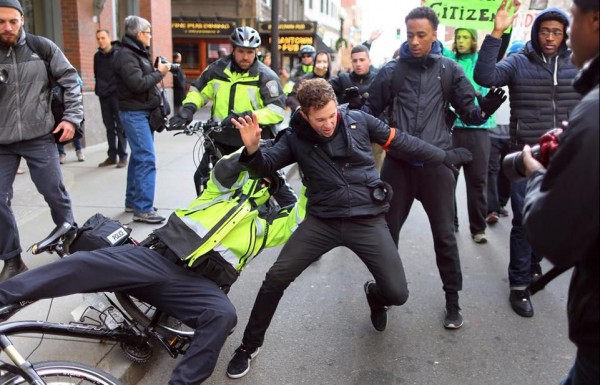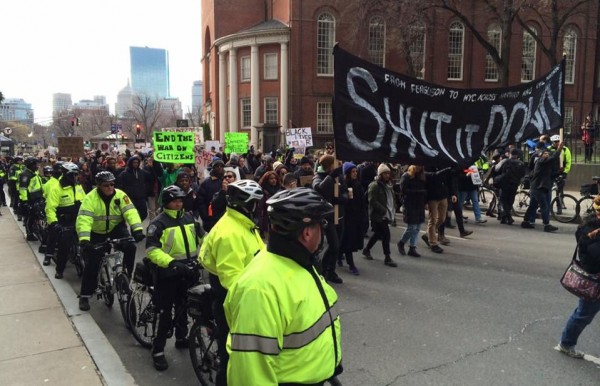I express my appreciation to the Boston Police for crowd control without excessive force at December 13’s protest march. Anything less would have been very unfortunate, particularly in connection with a peaceful march protesting use of force and police immunity from prosecution.
But there’s a different issue with police conduct at the march. A Boston Globe news story includes the report that “[t]here was also a brief altercation on Tremont Street near Boston Common, when a protester was pushed into an officer on a bicycle. The protester appeared to become angry and kicked the bicycle’s rear tire, causing the officer to fall. The officer rose and tackled the protester to the ground, but did not detain or arrest him.” The caption to the photo below, which ran with the story, reads “A Boston officer grabbed a protester who had knocked him off his bike on Tremont Street; the officer later let him go without charges.”

Police and protester scuffle on Tremont Street, December 14, 2014 (John Tlumacki photo for the Boston Globe)
Where this happened: (Google Street View)
Good police practice? If you’re around suspects or people you don’t know/trust, you don’t straddle the bike unless you are riding it. The officer in the back in the photo is also astride his bicycle.
Here’s another photo taken a few minutes earlier:

Boston police bicycle patrol lines up astride bicycles at start of protest march (John Tlumacki photo for the Boston Globe).
This photo was taken when the march had just started from Boston Common (Google Street View). The police officers were straddling their bicycles, at risk of being pushed over, as one in fact was.
The officers should have been walking alongside the bicycles, keeping the bicycles between themselves and the protestors and using the bicycles as a shield. These officers need to get to an IPMBA Bicycle Rapid Response class.
IPMBA is the International Police Mountain Bike Association, which trains police, paramedics and security guards in effective use of the bicycle.
The IPMBA blog offers an example of crowd control in Seattle. Quoting from the blog post: “On Monday night, when violence broke out during what had been peaceful protests, police officers, behind a wall of bikes, pushed protesters back in what some say is becoming the cutting edge of crowd control.” There is also a video showing these tactics. The Seattle protest was not peaceful, and the police response wasn’t pretty either, but on the other hand, it’s quite clear that the Seattle police tactics prevented injuries and property damage.
Police in some Massachusetts communities are trained by an outfit called COBWEB — Cops on Bikes with Education for Bicyclists — which has a very meager online presence. An officer from another city says this about training of Boston police:
“COBWEB has no connection to IPMBA at all. Boston EMS IS IPMBA trained and their Deputy Director Neal Blackington is also past Vice President of IPMBA and a really good guy. I’m not sure if BPD even uses COBWEB, they probably do their own thing. But I’m not sure. I know that Cambridge was using IPMBA years ago, but I have no idea now.”
A deeper examination of bicycling and police practice would have led the Globe to cite poor police tactics as contributing to the incident on Tremont Street, as I have done. Further examination might tell us more about training of Boston police and about COBWEB.
(I have used Boston Globe photos and text in this article as commentary, under fair-use provisions of copyright law.)

Pingback: Boston Police bicycle training | Street Smarts